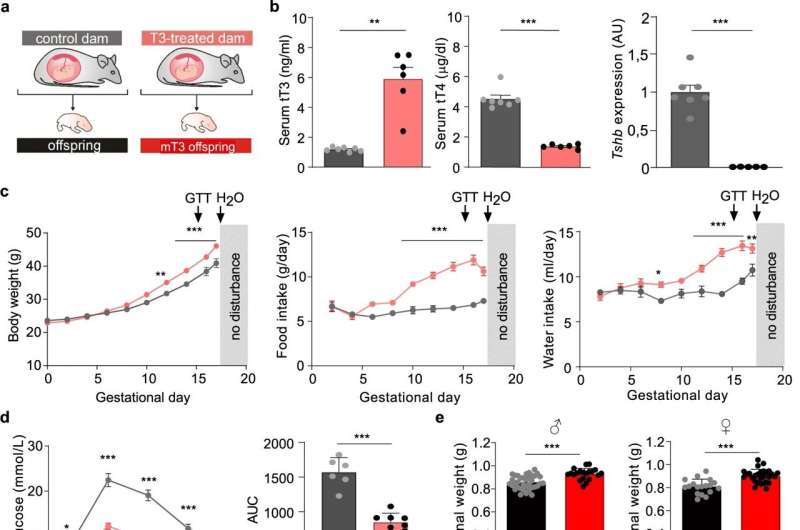This article has been reviewed according to Science X's editorial process and policies. Editors have highlighted the following attributes while ensuring the content's credibility:
fact-checked
peer-reviewed publication
trusted source
proofread
Thyroid hormones in pregnant women found to control brown adipose tissue in offspring

Brown adipose tissue (BAT) is a tissue that is utilized in babies to maintain body temperature. In adults, BAT is increasingly drawing the attention of researchers, especially in the context of obesity-related diseases, such as type 2 diabetes. Activating BAT could represent a promising therapeutic pathway to achieve metabolic improvement in the fight against the obesity pandemic.
Researchers at the "Center of Brain, Behavior and Metabolism" (CBBM) at the University of Lübeck have now deciphered a mechanism involved in the activation of BAT. The research team led by Prof. Jens Mittag, head of the Institute of Endocrinology and Diabetes at the University of Lübeck, found that thyroid hormones of the mother during pregnancy had an influence on the later activity of the BAT of the offspring. The study was published in the journal Nature Communications.
BAT is currently being intensively researched in the context of obesity and type 2 diabetes, as it is able to burn fat and release it as heat. Activation of this tissue is therefore promised to improve metabolism and provide a new therapeutic target in the fight against the obesity pandemic. It has recently been shown that lean people often have more brown fat than obese people.
However, it is still unclear why the activity of this tissue varies between individuals. Here, a research team of the Institute of Endocrinology and Diabetes at the CBBM of the University of Lübeck has obtained a first important evidence to solve this puzzle with the help of a mouse model.
"The key to brown adipose tissue activity seems to originate in the mother," reports Dr. Rebecca Ölkrug, first author of the study. "Mothers with high thyroid hormone levels during pregnancy had offspring with more active brown adipose tissue, while genetic blockade of the beta-thyroid hormone receptor in the pregnant mice triggered the opposite effect."
By analyzing maternal blood at the CBBM Metabolics Core Facility, the researchers were also able to identify a possible molecular mechanism: Choline, an important nutrient for pregnant women, is directly regulated by maternal thyroid hormones.
"Our study underlines the high significance of the mother's hormonal situation for the offspring," explains Prof. Jens Mittag, last author of the study. "Unfortunately, in contrast to gestational diabetes, the thyroid is still frequently forgotten in pregnant women. Yet the necessary clinical tests are easy to perform, and there are specific reference values and treatment guidelines from, for example, the European Thyroid Society for pregnancy."
More information: Rebecca Oelkrug et al, Maternal thyroid hormone receptor β activation in mice sparks brown fat thermogenesis in the offspring, Nature Communications (2023). DOI: 10.1038/s41467-023-42425-w




















